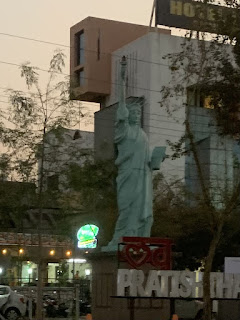I’ve got some catching up to do as I haven’t yet posted my thoughts on Aurangubad. Here are a few things that struck me that Norm hasn’t already mentioned in relation to our last two stops.
Apparently, Aurangubad is known as ‘the city of gates’. And certainly we passed many gates on our drive out to Ellora caves, about 20 kms outside the city. Difficult to photograph from a moving vehicle, but here is one:
Reminders of home appeared in the form of a Christian cemetery:
… and a replica of the Statue of Liberty!
I also noticed this sign posted regularly on the highway:
I don’t recall seeing this sign anywhere else, but it certainly seems pertinent. In India, no-one seems to pay attention to which lane they are on, and drivers weave in and out, often into the path of oncoming traffic. In some cities, they have erected concrete barriers down the middle of the road to prevent this, and yet still drivers cross over to the wrong side at intersections. Our drivers so far have been extraordinarily skillful in avoiding collisions, and I have realized that the constant ‘honking’ of horns, which I had previously assumed was due to irritation and frustration, is simply a way to let other drivers know you are there and intent on moving forward. I am usually a nervous passenger, and have been surprised at how calm I feel in the face of this ‘horn-honk opera’ as described in the book I am reading. India is having a calming effect on me!
Moving on to Mumbai, this city surprised me in many ways. Much more cosmopolitan than any city we have so far visited, and surprisingly easy to get around. As Norm has described it was an emotional moment to stand outside the apartment where he stayed with an Indian family back in 1977, before he started at medical school. Seemed like an important place to reflect on all that has happened since then.
Mumbai is certainly a city of contrasts, from the opulence of the Taj Palace hotel, to the slums that we drove past surrounding the airport. The book I am currently re-reading is Behind the beautiful forevers: Life, death and hope in a Mumbai undercity by Katherine Boo. I first read this about eight years ago, but it is coming to life in a new way now that we have spent time in Mumbai and I would really recommend it if you want to know more. Our hosts have been very careful, and a little defensive, when we have (hopefully sensitively) asked about the slums and people living on the streets and begging for food. Some have tried to describe these as a lifestyle or ‘career choice’, which is difficult to fathom. Hard to know whether they feel ashamed, impotent, or are simply wanting to present a more positive representation of their country in the hope that more people will visit. Norm posted a picture of a laundry in the slum area in Mumbai that we walked around, and while there was evidence that many of the residents were operating businesses and surviving, I cannot believe that many people would live there by choice. It was truly grim.
And yet still there was a vibrancy and sense of community everywhere we visited. Not sure I will ever be able to make sense of it. If you have visited India, and feel you have achieved a better understanding, I would love to hear from you – either in a comment on the blog or text/PM/email. Next, on to Kochi in the south.









No comments:
Post a Comment